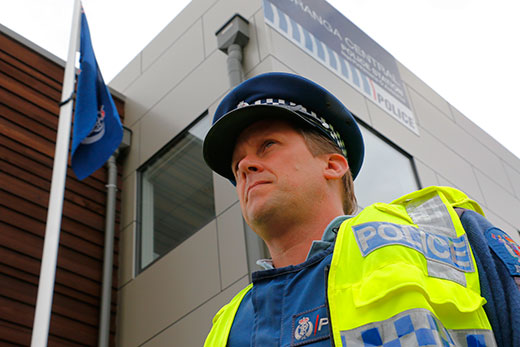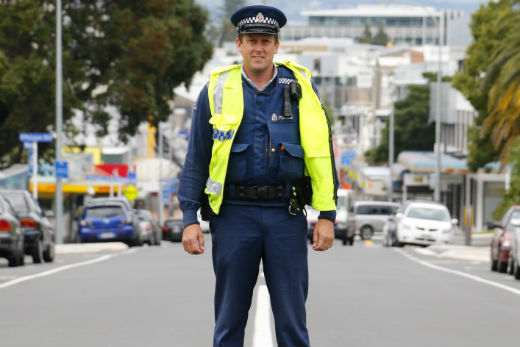Drivers in school zones need to be on their best behaviour even more so this week, with police cracking down on speeding around schools in an effort to help protect children.
Today marks the start of United Nations Road Safety Week, where the safety of children on roads around schools goes under the microscope thanks to road safety charity Brake.
Tauranga Police constable Paul Gunner will be helping police keep children safe on the roads as part of United Nations Road Safety Week. Photos: Bruce Barnard.
This year's theme is ‘Look out for kids', with Brake appealing to everyone to help keep children, some of the 'most vulnerable” road users, safe on roads.
According to Brake, 19 children are killed every year and more than 270 are hospitalised because of road crashes in New Zealand. Globally, more than 500 children die every day because of road traffic crashes.
It means speed limits are no more than 44km/h through urban zones, and 74km/h within 250m of rural schools on roads otherwise governed by a 100km/h speed limit, before classes start and after they finish each day.
Western Bay of Plenty road policing manager senior sergeant Ian Campion says motorists caught outside the 4km/h speed tolerance can expect a 'sliding” fine and loss of demerits depending on the excessive speed.
The fines range from $30 to $630 and Ian is hopeful none from the 'higher range” are handed out.
Police will be out in force this week keeping a close eye on motorists, with a number of random speed and child restraint related activities planned across the city.
Police are also teaming up with Plunket to run children restraint checkpoints where technicians will make sure restraints are properly fitted and children have the appropriately-sized car seat.
And they are checkpoints that couldn't come at a better time, according to Ian, following disappointing results from the 15th annual Kiddi Klick Week.
The annual car seat blitz saw almost a dozen children found without any form of restraint in cars on Western Bay of Plenty roads, while more than half of the children checked were in restraints which had fitting faults.
Of the 418 children checked, 11 were unrestrained and 270 had fitting faults, of which most have been described as 'potentially dangerous” in a crash situation.
'I think the vast majority of people take the care needed around schools,” says Ian, 'but there is the small minority that need to be reminded to really focus on what they are doing.”
Brake director Caroline Perry says road safety is a critical issue, and educators can play a pivotal role in helping reduce the risks children, families and young people face by teaching road safety, but also by raising awareness locally and encouraging drivers to slow down in the community.
Activities could include teaching children about being bright and seen and paying attention to the road, educating teenagers about the dangers of speeding when driving and how to be a responsible passenger or campaigning for local drivers to slow down outside a school or centre.
According to Safekids Aotearoa, about 23 children end up in hospital with serious road injuries each month.
A series of marches and events are expected across New Zealand to mark the global campaign.




1 comment
Great
Posted on 04-05-2015 15:33 | By EtcEtc
But also to help reduce kids being involved in accidents, the police need to heavily police the Welcome Bay roundabout lights, far too many people run lights at rush hour times.... There are far too many vehicles running red lights and the amount of times I have had to quickly grab a kid by the shoulders so they won't get hit is astounding
Leave a Comment
You must be logged in to make a comment.